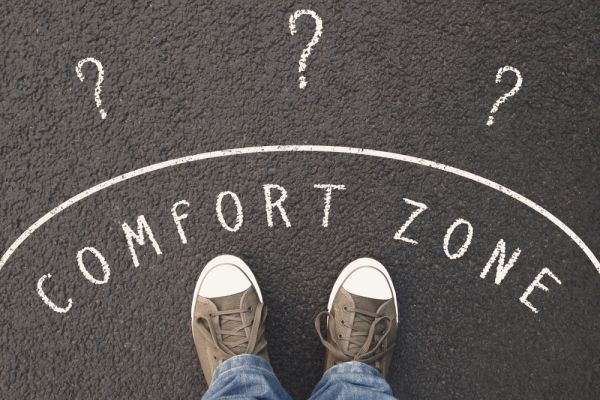The Biology of Anxiety
Anxiety is both a mental and physical state of negative expectation—mentally characterized by increased arousal and negative expectancy tortured into worry, and physically by activation of multiple body systems—all to facilitate coping with an unknown or adverse situation.
It is a state of defense presided over by nerve circuits of fear and activated by misperception or overestimation of threat from the environment, from the inner world of the body, or from the inner world of thought. Anxiety is a normal response to threat, and the discomfort it creates is meant to capture attention and stimulate a protective response. But too often, the anxiety is excessive, or sustained, or inappropriate to what set it off, and it interferes with every-day functioning—or sets in motion maladaptive behaviors, from avoidance of threat-generating situations to substance use, to avoid the discomfort of anxiety.
A number of neural structures play a role in anxiety, but the one that gives it its strong emotional color is the amygdala. The rational, thinking prefrontal cortex is responsible for interpreting the nature of the threat and orchestrating a behavioral response. Other brain areas also respond to the threat, and the signals they generate turn on the stress response, activating all the body systems for fight or flight..
Researchers believe that anybody can experience a bout of debilitating anxiety. But some people seem to be dispositionally inclined to anxiety: Their defense systems—possibly tuned by genes or temperament, possibly by early experience, possibly by over- or underactivity of some area of the brain—are poised to over-interpret neutral situations as threatening or to overreact to threatening situations.
On This Page
- What happens in the brain with anxiety?
- What areas of the brain are involved in anxiety?
- Why do I feel anxiety in my body?
- How do anxiety and fear differ in the brain?
- How do anxiety and depression differ in the brain?
- How does nerve cell communication go awry in anxiety?
- Why do I feel restless and unable to concentrate?
- Why can't I sleep?
- What do brain scans look at in anxiety?
- What do drugs target to relieve anxiety?
- What are the effects of anxiety on the brain?
- What happens in the brain with panic attacks?
Once the amygdala flags incoming information as a threat—or, due to hyperreactivity, jumps to that conclusion even in the absence of threat—it sends out an alarm, notifying many other areas of the brain to prepare for defensive action. It acts as if your life may be at stake. The hypothalamus relays the signal neurally and hormonally, setting off the stress response. Heart rate increases. Blood pressure rises. Breathing quickens. Areas in the brainstem switch on, pitching you into a state of high alertness and vigilance. The hippocampus, home of memory, draws on past experience to try to put the nature of the threat into context. The prefrontal cortex, which receives all the information to create a coherent interpretation of events and to orchestrate an appropriate behavioral response, can dampen or amplify the sense of threat and degree of distress. In the anxious brain— whether through overexcitability of the stress response system, the activity of various neurochemicals, impairments in nerve circuitry, or inactivation of specific cell populations in the prefrontal cortex—the amygdala essentially overpowers the prefrontal cortex.
Anxiety starts when the central emotional processor known as the amygdala—or the so-called “extended amygdala,” which encompasses the bed nucleus stria terminalis (BNST)—interprets incoming stimuli from the inner or outer world as a threat. A distress signal is sent out to many other parts of the brain, including the hypothalamus, which in turn relays the signal to the rest of the body by switching on the sympathetic nervous system. The release of epinephrine (adrenaline) from the body’s adrenal glands jolts the brain into alertness, sharpening senses and demanding hypervigilance of the environment. The amygdala also communicates with the hippocampus, repository of memory, which can put the threat signal into comforting context—or not.
Normally, through their many interconnections, the prefrontal cortex, seat of executive functioning, exerts control over the emotional output of the amygdala. But the negative emotional signals emanating from the activated amygdala, amplified by the excitatory neurotransmitter glutamate, disrupt cognitive functioning, including decision-making, and keep the prefrontal cortex from switching to other matters. Anxiety short-circuits the decision-making process by literally suppressing the normal activity of specific populations of neurons in the prefrontal cortex.
Regardless how real or imagined a threat is, anxiety is a response to perception of danger. It is both psychological and physical. The brain’s amygdala makes the determination of threat and signals the hypothalamus, a central command center, which broadcasts the signal through the autonomic nervous system and sets off a cascade of hormones, including adrenaline. Body and mind prepare as if your life were at stake.
Before you even have a chance to ponder the nature of the danger—before the hippocampus, seat of memory, has a change to put the threat in the context of past experience—you are jolted into alertness and begin searching everywhere for signs of trouble; you can’t concentrate—and you can’t sleep. Your body prepares you for rapid action. Your heart begins pumping blood fast. As your heart rate goes up, so does your blood pressure and your breathing rate. You feel muscular tension, even twitchiness. You may feel a headache or stomachache. Many people experiencing anxiety seek treatment for the bodily symptoms, believing they must be due to physical causes, without the true source of the problem being discovered.
All animals experience fear. But the evidence suggests that only humans experience anxiety, which has been called “the price we pay for an ability to imagine the future.” Fear is a response to a direct threat. Anxiety is a response to a possible negative outcome ahead. But both fear and anxiety utilize much of the same neural circuitry, with the amygdala flagging incoming stimuli as threatening and turning on defense systems of body and brain—vigilance, muscular tension, rapidly beating heart. The amygdala overpowers the rational part of the brain, the prefrontal cortex, that normally interprets and regulates emotional experience and directs a behavioral response. Much of that brain machinery overlaps in fear and anxiety.
But the unique element in anxiety is the capacity to imagine some negative future outcome. Anxiety can be considered a condition of suffering from imagination. Imagination is a kind of mental tinkering with various kinds of information stored in different parts of the brain. At the very least it involves the capacity to manipulate mental imagery, which centers in the visual cortex. Whether positive or worrisomely negative, imagination is a very complex capability that is still largely uncharted territory, including its role in anxiety.
The symptoms of anxiety and depression overlap in many ways—both conditions create irritability, insomnia, and difficulty concentrating, for example. Researchers know that some of the same brain centers are involved in both conditions—such as the amygdala, commonly called the fear center but more appropriately thought of as an emotion center, and the hippocampus, seat of memory. But scientists are still actively disentangling the relative contributions of the amygdala and the hippocampus in the two disorders, and the relationship between the two areas is now the focus of much attention.
Normally, the hippocampus is an important way station in the interpretation of all incoming information. From its memory bank, the hippocampus puts stimuli in context so the brain can figure out how to handle situations. Depression impairs the functioning of the hippocampus and actually shrinks its size. Anxiety, on the other hand, enlarges the hippocampus. It turns on a small group of cells researchers now refer to as “anxiety cells”—for example, in studies of animals, the cells fire only when the animals are in places that are innately frightening to them.
Through messaging to other parts of the brain, the firing of the anxiety cells then turns on many of the behaviors associated with anxiety, including avoidance of any situations that bring on the discomfort. The anxiety cells of the hippocampus also signal the hypothalamus, a switching center that communicates with the body; they trigger the hypothalamus to produce many of the symptoms you experience in anxiety— increased heart rate and breathing, muscular tension. The brain signals in anxiety also command visual centers to heighten visual attention. The resulting hypervigilance represents one of the many ways the brain overestimates the possibility of threat, the hallmark of anxiety.
Researchers and clinicians once focused on the role of neurotransmitters in anxiety and its close cousin depression. Over the past 25 years, however, it has become clear that neurotransmitters are only one part of a much larger story of how nerve cells function in circuits to relay messages from one part of the brain to another. In fact, many experts see anxiety as a nerve circuit disorder, marked by a power disruption in the brain’s wiring, affecting communication between one area of the brain and another.
The nerve cell connections between the amygdala and the prefrontal cortex (PFC) are critical in anxiety. Anxiety results when alarm signals of possible danger originating in the amygdala disable the PFC so that it can not ignore or in any way regulate the signals. In fact, the PFC sends out signals that intensify amygdala activity, and the PFC winds up collaborating in the loss of its own control over the amygdala. The hyperactive amygdala also bullies the visual center of the brain to maintain constant vigilance, ever on the lookout for threats, allowing the misinterpretation of benign stimuli as dangerous ones.
Restlessness is anxiety’s badge of readiness for protective action. Anxiety is by definition a brain state of unease, and a heady cocktail of hormones unleashed by the perception of threat works diligently to maintain a state of preparedness for action. Alarm signals of possible danger sent from a hyperactive amygdala prompt the release of adrenaline to put many systems on high alert for immediate action. Visual systems go on permanent watch, specifically searching for signs of trouble and biased to notice them even when they don’t exist. Every muscle of the body is twitching with anticipation that some bad outcome lies just ahead, twitching with the possibility that fight or flight might be necessary. Restlessness is part of the price of protection for an organism that has the gift of imagining the future.
Anxiety and insomnia are exquisitely uncomfortable but longstanding bedfellows; studies show that anxiety brings on insomnia in the vast majority of cases. Anxiety sets up a vicious cycle with sleep. Anxiety is a state of neural and general physiologic arousal. The hypervigilance that is a hallmark of anxiety keeps the brain in a constant state of unease, on high alert for threat, interfering with the ability to rest. The resulting loss of sleep creates fatigue, irritability, and inability to concentrate during waking hours, eroding ability to manage anxiety or attend to any of the matters that serve as the source of concern or threat. Researchers find that brain activity after periods of sleep deprivation mirrors brain activity indicative of anxiety disorders. The emotion-generating amygdala is especially active after sleep deprivation, while brain regions that normally modulate emotional experience are muted. In fact, sleep deprivation can cause an anxiety disorder. Sleep disturbance is a diagnostic symptom of anxiety disorders.
Some types of brain imaging, such as CT scans and magnetic resonance imaging (MRI), take static pictures of the brain to determine whether any specific structures are larger or smaller than normal in anxious patients. Positron emission tomography (PET) scans and functional magnetic resonance imaging (fMRI) look at the brain in action, to see whether and where there are problems in the way the brain processes specific types of information. They delineate the circuitry of anxiety, indicating which parts of the brain play a role in the disorder.
In fMRI studies, normal controls and anxious patents are typically given some task to perform in the scanner. For example, subjects may be asked to look at a series of pictures, some of them with emotionally disturbing content, to see how the brain handles negative and, particularly, threatening stimuli. The brain scanners measure blood flow or metabolic activity, based on the concentration of tagged agents earlier injected into the bloodstream. Comparison of hot spots and dead spots of activity between controls and anxious patients highlights areas of the brain that malfunction in response to the stimuli. Such studies consistently show heightened activity in the amygdala, which flags emotional information as alarming, and underperformance in areas related to shifting attention away from troublesome thoughts and controlling emotional response.
There is no one drug target in anxiety—at least not yet. The first line of pharmacological defense against anxiety disorders (except panicCK) is the SSRIs, or selective serotonin reuptake inhibitors, such as citalopram (Celexa) and fluoxetine (Prozac)., and their first cousins the SNRIs, selective noradrenaline and serotonin reuptake inhibitors, such as duloxetine (Cymbalta) and venlafaxine (Effexor). They have been widely studied, and most clinicians find that, as in depression, such drugs have limited efficacy and limited duration of effects—largely because they reflect the limited understanding of anxiety and its twin disorder, depression, that existed 30-plus years ago, when they were developed.
Both groups of drugs are aimed at boosting concentrations of one neurotransmitter or another, in the belief that anxiety (and depression) results from a chemical deficit in the brain. The drugs block the reuptake of serotonin or noradrenaline at synapses, thus increasing levels of the neurotransmitters. Huge gains in the study of the brain over the same time show that anxiety is an enormously complex disorder, involving many parts of the brain forming a circuit dealing with signals of threat. Researchers still have not nailed down exactly which parts of the brain play a role in the disorder, under what conditions, and exactly what that role is. Anxiety is particularly elusive because the stimuli to worry are so idiosyncratic and memory-specific.
Another class of drugs often used to treat anxiety is the bendodiazepines, including Valium, Xanax, and Klonopin. They curb anxiety by exerting a generally sedating effect on the brain, and they, too, act by targeting neurotransmitters, specifically acting on brain receptors for GABA, the brain’s inhibitory neurotransmitter, to increase its levels.. More GABA available slows down the brain and tamps down all nervous system activity. Benzodiazepines have been used since the 1950s as tranquilizers and sedatives to facilitate sleep, and all bear a warning label that they can create dependency.
Anxiety is the number one mental health problem in the world. There is widespread hope that by targeting one or more brain centers involved in neural circuits of anxiety, science will find a drug that is effective in curbing the condition.
Generalized anxiety disorder can have negative effects on many brain structures and functions including cognition, changing the way we think. For one, it biases the brain toward noticing the negative, predisposing to depression as well. The brain becomes hyperreactive to threats, seeing neutral events as threatening and responding with worry—rumination about possible bad outcomes.
The three main brain centers in the circuitry of anxiety—the amygdala, the hippocampus, and the prefrontal cortex (PFC)—are all subject to lasting shifts in structure and function as a result of the disorder. Most notably, the amygdala grows in size and output, biasing it to issue false alarms of danger. The PFC shrinks in size and activity, weakening its ability to make sense of emotional experience and direct an appropriate response. The impairment of cognitive function is not limited to processing emotional information but extends to all problem-solving. For its part, the hippocampus preferentially holds on to threat-related memories. Further, the corrosive effects of anxiety on the PFC and hippocampus set the already compromised brain up for dementia, such as Alzheimer’s disease.
Panic attacks are dramatic bursts of anxiety that feel acutely life-threatening but are not. The body sensations of anxiety—pounding heart, racing pulse, the feeling of difficulty taking in air—become so intense so quickly you feel as if you are having a heart attack and are about to die. That interpretation is mistaken, but it triggers even more anxiety, intensifying the panic. Experts find that something goes wrong in the normal brain circuits of communication between the emotional output center of the amygdala and the cognitive processing and regulation center of the prefrontal cortex (PFC). Overwhelmed by signals from the amygdala, the prefrontal cortex does not realize that the threat is not real. People differ in the degree to which they are aware of their inner workings of their body (interoception), and there’s some evidence that those who are subject to panic attacks are especially highly attuned to body sensations.














